Pistol Barrels: The Ultimate Guide
 Bryan Hill / March 21 2024
Bryan Hill / March 21 2024
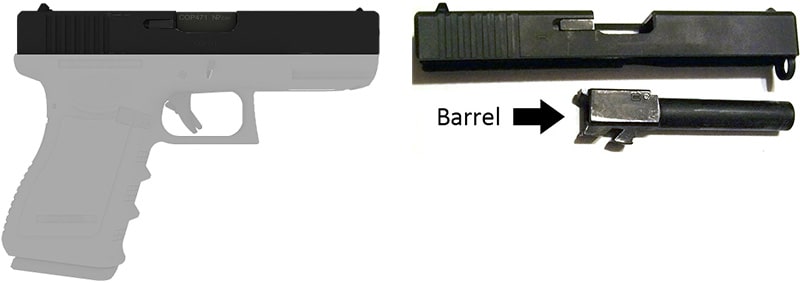
A pistol's barrel imparts power to your shots, and affects accuracy, but not the way you think.
We'll cover what a pistol barrel is, how you can upgrade it to help you defend yourself,
and address common questions and myths using expert testimony, physics, and case studies from real-world shootings.
On This Page:
- What is a Pistol Barrel?
- What is Pistol Barrel Length?
- What Can I Get Instead of a Longer Barrel?
- Should I Upgrade My Barrel?
- Which Pistol Has The Best Barrel?
- References
What is a Pistol Barrel?
The barrel sits inside the
slide.
On a Beretta 92, the slide is mostly cut out, with the barrel showing:
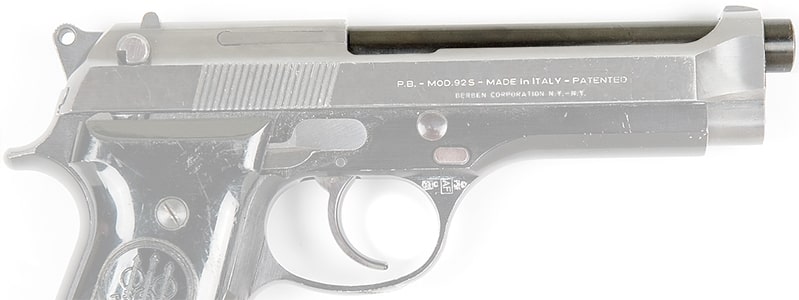
When you fire a loaded pistol, the
bullettravels out the barrel, exiting the
muzzle, or forward end of the barrel.
Watch as the Beretta 92 is fired:
This is why
the rules of gun safety refer to the muzzle, and not the whole barrel.
Not all barrels are the same. They can change your pistol's:
-
Power
-
Accuracy
-
Recoil
-
Loudness
These all depend on a barrel's
length and
type.
What is Pistol Barrel Length?
 Should you get a bigger pistol just for a longer barrel?
Should you get a bigger pistol just for a longer barrel?
A longer barrel gives more power to your shots.
And unlike with
+P ammo,
you don't trade extra
recoil for it.
Sounds great, right?
Not always.
Pistol Barrel Length vs. Velocity (Power)
In pistols, there are
rapid gains from a barrel at least 3" long: 10% or more per inch.
Beyond that, there are diminishing returns.
Power Gained Per Inch
Cumulative Power Gained Per Inch
Why do the gains drop off? When you fire a pistol, gunpowder in the ammunition ignites, creating a small blast.
This drives the
bulletout the barrel.
Pistol rounds are designed to burn all that gunpowder in the first 3-4 inches of barrel.
If a barrel is too short, it's like removing some of the blast behind the bullet.
Part of the blast erupts outside the barrel, making brighter, louder flashes.
Longer barrels concentrate more power behind the bullet, but don't add any blast.
The Shocking Truth about Pistol Power
Going for more power in a pistol usually has no practical effect.
Why? This will sound a bit icky, but we have to talk about
terminal ballistics: what bullets do when they hit a live target.
When a bullet enters the human body, it creates a
temporary wound cavity and a
permanent wound cavity.
If you've looked at ballistic gel tests, you can see the temporary cavity is much larger than the permanent one. More powerful pistol rounds make bigger temporary cavitites in gel.
But this doesn't matter. Why?
Human tissue is elastic, so much that the temporary cavity is just that: temporary.
It may feel unpleasant for a split second, but it's not what stops a threat.
Only rifle rounds and
a new type of pistol ammo
can exceed the elasticity of human tissue, and cause the temporary cavity to become permanent.
Here's Johann Boden with Federal Ammunition explaining more:
With a pistol, you only get an immediate stop if you hit the brain stem, which is tiny:
If you hit the heart, you get a guaranteed stop within 10 seconds:
But with a rifle, you can effectively "hit" those spots even if you missed them by a few inches.
A rifle bullet hits so hard that the temporary cavity becomes a permanent cavity.
There's a saying: "A pistol's a pistol, and a rifle's a rifle". This is why.
With a pistol,
more power won't stop the threat faster.
Only two things matter when you're shooting 9mm or stronger ammo:
-
Permanent wound cavity: The size of the holes you punch in the threat.
-
Shot placement: Where you place those holes in the threat.
For .380 ACP, also consider penetration. Why? Many loads of .380
don't penetrate enough to hit vitals. Verify your defensive .380
ammo gets at least 12" of penetration in ballistic gel tests, and if
you're in a colder climate, look for 14" or more to offset heavy clothing.
What Is More Power Really Good for in a Pistol?
-
More Reliable Hollow Point Ammo.
Hollow pointsneed
to hit with enough power to expand as designed.
-
Stopping large animals.
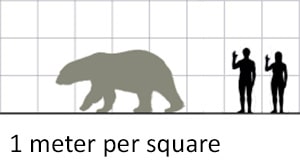
Bears, moose, and other large animals have thicker bones than people.
A pistol needs more power to penetrate those bones and hit vitals.
A longer barrel could give you the power you need to turn a deflecting hit into a penetrating one.
-
Effective range.
After firing a gun, the bullet loses power as it travels.
Extra power from the barrel cancels out power lost from bullet travel.
+1 inch of barrel length adds 20-40 yards of effective range.
Cumulative Power Lost by Distance
Pistol Barrel Length and Accuracy
When you fire a gun, the barrel vibrates.
The longer the barrel, the more it whips around at the muzzle:
That whipping action is like a sine wave:
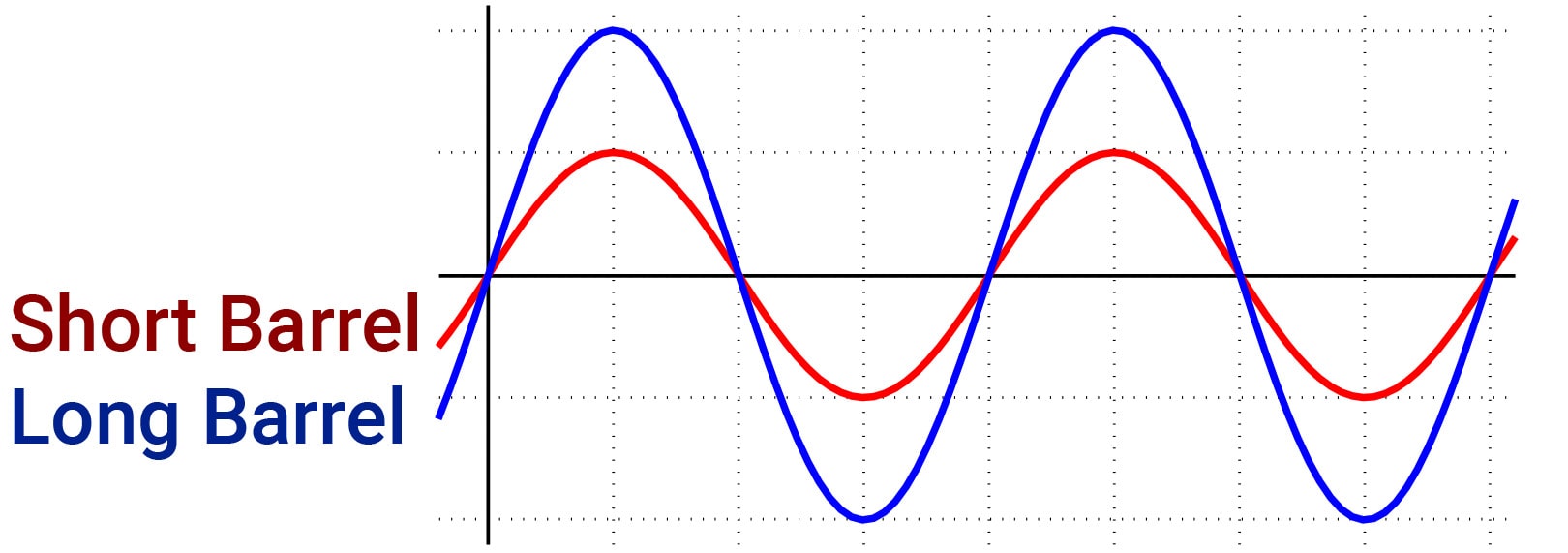
The bullet's path is set the moment it exits the muzzle, and that path depends on where the barrel is in its vibration.
If all bullets took the same time to exit the barrel, and the barrel vibrated the same way every time, you'd have perfect accuracy.
But the amount and quality of gunpowder launching that bullet isn't perfect, so one bullet travels out the barrel faster or slower than another.
One bullet may exit at the top of the sine wave, while another at the bottom, or somewhere between.
So, without other factors to increase accuracy,
a longer barrel is less accurate than a short one. A bigger sine wave is less accurate.
Pistol Barrel Length and Recoil
Longer-barreled pistols have more recoil energy, but less felt recoil.
How does that work?
To leave the barrel, the bullet makes an equal and opposite reaction, like it's pushing off of your gun to jump at the target. That's the recoil force.
A longer barrel launches that bullet faster, so it jumps off of your gun harder.
But the extra weight of a longer barrel absorbs more recoil than its extra length creates, so you feel less recoil.
To most people, this just means a longer-barreled pistol has less recoil. One inch of extra length won't mean much, but the more inches, the more you notice.
When to Get a Longer Barrel
Backwoods (Bear) Defense

For a pistol made to stop large animals (bears, moose, etc.), a longer barrel can be a great choice. Why?
-
No need to conceal the pistol in bear country (if carry is legal).
-
To stop a dangerous animal, one must shoot it in the brain or heart.
-
The brain and heart are protected by bones.
-
Only powerful pistols can penetrate the bones of larger animals.
What Can I Get Instead of a Longer Barrel?
To answer this, we must first look at the
other barrel types.
Stock Barrels for Cost Savings
A stock (or factory or OEM) barrel comes with your pistol.
It's the standard that other barrel types are compared to.
It's the best option if you want to save money.
If you ever want to replace a stock barrel with another, they cost
$150 or more.
Best Uses
Match Barrels for Max Accuracy
Match barrels look like stock barrels, but they're made to higher quality standards.
They're also made to have a tighter fit inside the
slide.
Pros
Adds accuracy. At 25 yards, groups will be 1/4 an inch to 2 inches tighter.
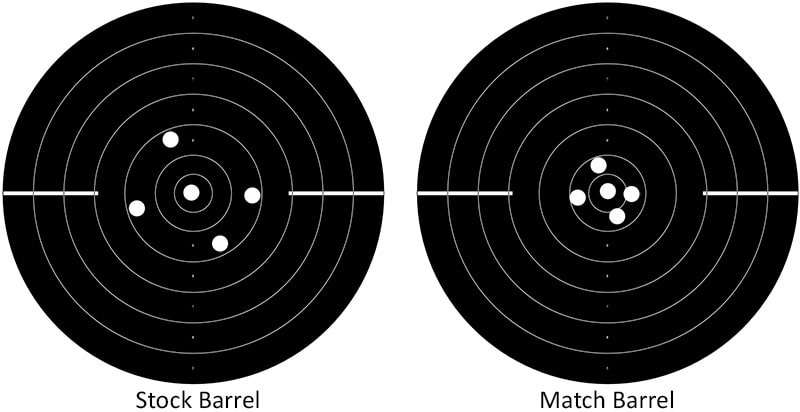 A match barrel can tighten your groups by 2 inches at 25 yards. Can you shoot 2-inch groups?
A match barrel can tighten your groups by 2 inches at 25 yards. Can you shoot 2-inch groups?
The accuracy bonus depends on:
-
Make/model of the pistol. Some are more accurate than others by default, so there's less room to improve.
-
Quality of the match barrel. "Match-grade" is not a standard!
-
Fit: How tight the barrel fits in the slide compared to the stock barrel.
Cons
-
Cost ($150-225).
-
You won't notice the accuracy bonus unless you're skilled enough to shoot 2-inch groups or smaller.
Best Uses
-
Competition shooting in Production Division (minimum modifications allowed).
Bull Barrels for Accuracy and Faster Fire
Bull Barrels are shaped like a cone, with the muzzle being thickest.
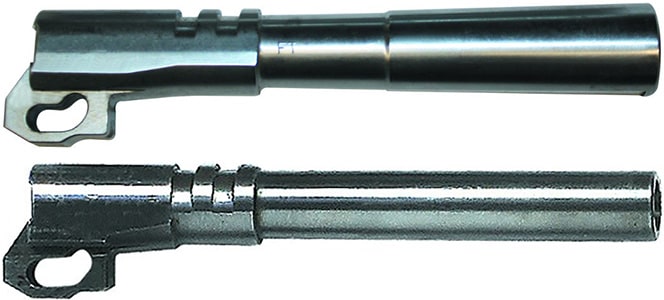 A bull barrel, above, and a standard barrel below it.
A bull barrel, above, and a standard barrel below it.
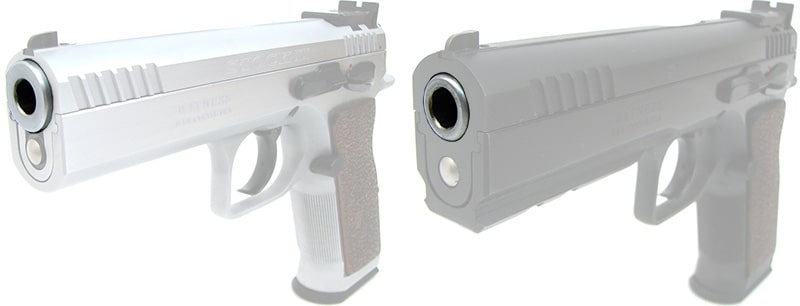 Bull Barrel on the left. Notice the thicker barrel.
Bull Barrel on the left. Notice the thicker barrel.
Pros
-
Adds accuracy.
Bull barrels are thicker than standard barrels. Thickness adds stiffness.
Stiffness adds accuracy. Remember how gun barrels are like a sine wave when fired? A stiff barrel shrinks the wave down, like a shorter barrel does.
-
Reduces recoil about 5% for faster shooting. It's just enough to notice.
A pistol's recoil mostly comes from the slidemoving back.
Extra weight not in the slide reduces recoil. Weight in the framereduces it even more.
Cons
-
Cost ($250-325).
-
Needs a special slide ($150-200). Bull barrels don't fit slides made for standard barrels.
Find a pistol or slide assembly made for bull barrels by default.
Best Uses
-
Concealed carry.
-
Competition shooting in Production Division (few upgrades allowed).
Ported Barrel for Rapid Fire
Ported barrels have cuts in the top of the barrel.
When you fire a the pistol, gasses push the bullet out the barrel. A ported barrel vents some of those gasses up.
There are two types:
Internally Ported
Internally-ported barrels have cuts where the slide would cover them.
They are as long as a stock barrel, but require a slide cut with windows or holes to work with the ports.
 Internally-ported barrel with vertical ports, left, and diagonal ports, right.
Internally-ported barrel with vertical ports, left, and diagonal ports, right.
Externally-ported
These only have ports outside of the slide. They're longer than stock barrels.

Pros
Both types
-
Reduces recoil20-35%, for faster shooting.
Cons
Both types
-
Cost ($150+).
-
Bullets lose 2-6% power. This is like cutting an inch off the barrel.
-
Shooting from retentioncan be uncomfortable or disorienting.
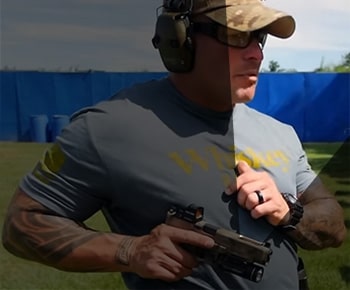
The path of the gasses from a ported barrel. What happes if he angles the gun up higher?
If your pistol is held too close, the gasses vented up by the ports can spray into your face.
It's uncomfortable - like hot sand thrown in your face.
If you're not wearing eye protection, this can disorient you for a moment.
If you breathe in these gasses repeatedly during extended practice or training retention shooting, you will feel sick.
This is less an issue for diagonal ports, since the gasses get blown away from your centerline.
-
Bullet fragments can spall out of the ports with Plated ammo.
As the bullet comes out the barrel, it scrapes on the ports and shaves off material.
If enough material builds up, it blocks the port. On the next shot, the material pops out like a champagne cork.
This won't hurt anyone unless it hits them in the eye.
With the pistol presented, people next to you are most at risk.
When shooting from retention, this becomes a major risk if you're not wearing eye protection.
This is not an issue with FMJ ammoor quality defensive ammo.
We only recommend such ammo on this site.
Internally-ported
-
Needs a special slide ($150+). Internally-ported barrels need slides cut with windows to match the ports.
Find a pistol or slide assembly made for ported barrels by default, or have a gunsmith make the cuts.
-
More cleaning.
The spalling issue means you should clean the ports, barrel, and inside of the slide after each live fire session.
Externally-ported
-
Adds 3/4 inch to barrel length. This can make it harder to carry/conceal.
Best Uses
Internally-ported
-
Concealed carry (compact or pocket pistols with a light).
Externally-ported
-
Concealed carry (compact pistols with a light).
-
Competition shooting (Open Division, lots of modifications allowed).
Threaded Barrels for Versatility
 Threaded barrel. Thread protector on the left.
Pros
Threaded barrel. Thread protector on the left.
Pros
-
Attach muzzle devices to your barrel: Compensators or suppressors.
-
Compensators reduce recoil by 25-40%.
-
Suppressors reduce loudness of your shots by 14-43 decibels (dB).
(An unsuppressed 9mm shot is 160 dB. 120 dB is painful, causing hearing loss)
Cons
-
Cost ($175+).
-
Adds 1/3-1/2 an inch to barrel length. This can make the pistol harder to carry. Muzzle devices add even more length.
-
Threads can get damaged if left bare, or by poorly-designed muzzle devices.
-
Muzzle devices can hurt accuracy if they come loose.
-
Compensators and suppressors each have their own drawbacks.
Learn more:
Best Uses
-
Home defense.
-
Duty carry.
-
Concealed carry (compact pistols).
-
Competition shooting (Open Division, lots of modifications allowed).
Should I Upgrade My Barrel?
-
Pocket Carry: No.
Match barrels aren't worth it for shooting within 7-10 yds.
Ported barrels haven't worked well in pocket pistols.
A threaded barrel usually makes the pistol too big to fit in a pocket.
-
Compact Carry: Maybe. If your holster and outfit
can take the length of a full-size pistol, get a threaded barrel and micro-compensator.
Why? You get about the same overall length of a full-size pistol, but reduce recoil 25-40%.
-
Duty Carry: Yes. Match or threaded barrel with a compensator.
-
Home Defense: Yes. Match or threaded with a compensator or suppressor.
Why? A full-size compensated or suppressed pistol might be long and heavy, but you're not carrying it all day.
-
Competition: Match or bull barrel for divisions like Production (few upgrades).
In Open division (many upgrades), ported barrel or threaded barrel with a compensator.
-
Bear Defense: A long match barrel for power and accuracy,
or a threaded barrel with compensator for faster accurate shots.
Just keep your holster options in mind.
Which Pistol Has The Best Barrel?
Several pistols come in versions with a threaded barrel, for less than it would cost to upgrade the barrel aftermarket.
The Canik TP9 Elite Combat stands out with a threaded match barrel.
It's a great choice for duty carry or home defense:
Best Deal Guarantee
Updated hourly
Canik TP9 Elite Combat
Compare Prices
|
Related Articles
Feedback
Are you happy with this page?
References
-
Compensated and Ported Handguns in Low Light (2018)
-
How Compensators Help You Shoot Faster (2017)
-
Compensated Handguns (2017)
-
Barrel Race 2017 (2017)
-
Glock Precision Barrel Test #1 (Ransom rest OEM/KKM/S3F/ZEV/Wilson) (2016)
-
Pistol Recoil Reduction: Ports vs. Compensator (2015)
-
Ballistic Calculator (2015)
-
9mm Ballistics Chart & Coefficient (Luger) (2015)
-
Mag-na-port Gun Recoil Reduction- review and high speed comparisons with Jerry Miculek (2013)
-
Dr Andreas Grabinsky Lecture on Gunshot Wounds (2013)
-
SNIPER 101 Part 7 - Rifle Vibrations & Harmonics EXPLAINED (2012)
-
Marines Fire AK-47 in Slow Motion (2012)
-
Ballistics by the Inch: .380 Auto (2011)
-
Ballistics by the Inch: 9mm Luger (2011)
-
Ballistics by the Inch: 10mm (2011)